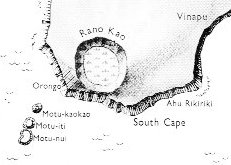2. I think time is ripe to show the summary page of hau tea in my outline glyph dictionary: The hau tea glyph type is a stylized picture of the horizon in the east with a sun 'eye' (at right in the glyph) together with the horizon in the west (at left in the glyph), connected by (in the north) the 'roof of the sky' with vertex at noon:
Sky 'roof', sun 'eye', and the two horizons where sun will rise and go down, are connected, and in between is a rectangular area in which Easter Island lies. In the middle of the glyph a third vertical line is drawn as a theoretical construct (not real, not connected with the rest of the glyph). It is the imagined line between Vinapu and Anakena, a line reaching from the south pole to the north pole, a line for 'generating fire'. It is a line to induce a new 'sun' (year) in midwinter after the old one has 'gone out' (cfr the glyph type vae and also how the Polynesians used a 'fire plow' for creating new fire). The meaning of hau tea is basically 'day light', the kind of light which during summer magically makes everything grow. Although written a few years ago (maybe with some unwarranted conviction) it is still remarkably on the point and very much in harmony with what has been discussed recently. The plough is an instrument not only to turn Mother Earth over again, to enable her to produce the food without which we would die, but it can also be a tool for creating fire. Earlier it had puzzled me why Vinapu was not due south from Anakena, but more to the southwest. But Anakena is where the Sun King arrives and his departure should be in the southwest, where he is falling on his face. The rooster of Ariana who was called on to crow softly could be illustrated in Gb7-1:
... The people (mahingo) listened as he spoke. The king called out to his guardian spirits (akuaku), Kuihi and Kuaha, in a loud voice: 'Let the voice of the rooster of Ariana crow softly. The stem with many roots (i.e., the king) is entering!' The king fell down, and Hotu A Matua died. Then all the people began to lament with loud voices. The royal child, Tuu Maheke, picked up the litter and lifted (the dead) unto it. Tuu Maheke put his hand to the right side of the litter, and together the four children of Matua picked up the litter and carried it ...
I will take the opportunity to quote from Barthel (in his The Eighth Island): "1. Hanga Te Pau, the landing site of Ira and his band of explorers, is the natural anchorage for those approaching Vinapu by sea. The remarkable stone fronts of the ahu of Vinapu are all facing the sea. The explorers landed at Hanga Te Pau during the month 'Maro', that is, June ... 2. The cult place of Vinapu is located between the fifth and sixth segment of the dream voyage of Hau Maka. These segments, named 'Te Kioe Uri' (inland from Vinapu) and 'Te Piringa Aniva' (near Hanga Pau Kura) flank Vinapu from both the west and the east. The decoded meaning of the names 'the dark rat' (i.e., the island king as the recipient of gifts) and 'the gathering place of the island population' (for the purpose of presenting the island king with gifts) links them with the month 'Maro', which is June. Thus the last month of the Easter Island year is twice connected with Vinapu. Also, June is the month of summer solstice [a mistake: south of the equator it is winter solstice], which again points to the possibility that the Vinapu complex was used for astronomical purposes. 3. On the 'second list of place names', Hanga Te Pau is called 'the middle (zenith) of the land' (he tini o te kainga). This may refer to a line bisecting the island, but it can just as easily mean the gathering of a great number (of islanders). The plaza (130 x 130 meters) would have been very well suited for this purpose. 4. The transformation of the 'second list of place names' into a lunar calendar links Hanga Te Pau and Rano Kau. A similar linkage occurs in connection with the third son of Hotu Matua between the 'pebbles of Hanga Te Pau' and his name 'Tuu Rano Kau'. There can be no doubt that Vinapu was dependent on the economic resources of the large crater ..." |

